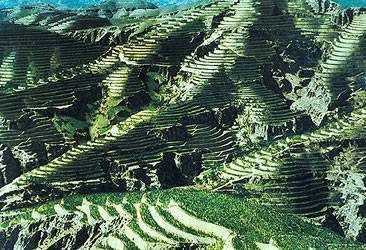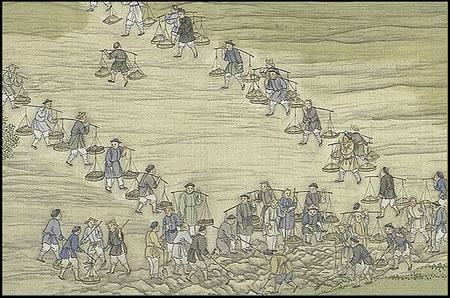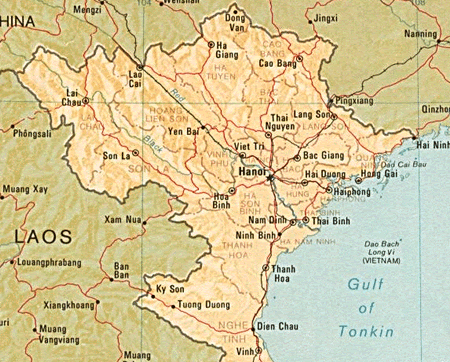Human Actions Modify the Physical Environment
The modification of physical environments in order to develop highly productive agricultural systems in China, Japan, and Korea has a long history. The control of water, terracing, and the use of organic fertilizers over millennia have been critical elements in the fashioning of agricultural landscapes in East Asia. These efforts brought about not only highly productive agricultural systems based upon irrigated rice, but also landscapes of extraordinary beauty. Industrialization and consumerism, however, have accelerated over the past half century, leading to issues of depleted resources.
Agriculture
JAPAN: Rice in Japan
- The Miracle of Rice [Japan's Secret Garden, NOVA, PBS]
A reading about the cultural and economic significance of rice in Japan. Also discusses the "rice crisis" throughout Asia. With a video clip showing changes to a rice terrace over a growing season. Also see the animated feature, Build a Rice Paddy, which takes the viewer step-by-step through the process of how a terraced rice paddy is constructed.
- Wet Rice Agriculture [Asia for Educators]
A short reading about wet rice agriculture.

-
How a Paddy-field Works [The Imaginatorium]
Focusing of the Kanto Plain in Japan, this website uses text and images to show clearly the agricultural cycle, including each step from preparing the field for planting through harvesting. Here, important innovations in technology reveal the ways that Japan has used mechanization to overcome reductions in the size of the farming population.
- Center for International Earth Science Information Network (CIESIN) [Columbia University]
Provides online data — including maps and statistics — that help students and teachers understand the interrelatedness of the social and natural sciences in terms of environmental and other issues. The links below are examples of what can be found on this site:
- CIESIN Thematic Guide: Agriculture and Global Environmental Change
Select Indigenous Agricultural and Environmental Knowledge Systems under key issues for text with embedded links on a wide range of related topics. Select the phrase "examples of indigenous farming systems, practices, and knowledge," (fifth paragraph) for more text with examples that include Chinese orange grove insect control with ants, use of ponds for aquaculture, and more.
- CIESIN Thematic Guide: Agriculture and Global Environmental Change
- Rice Knowledge Bank International Rice Research Institute [IRRI]
CHINA: Controlling Water Resources
• Terracing and Irrigation
-
Arteries of Empire [Asia for Educators]
This reading for students discusses China's hydraulic (water control) system and important improvements over time in canal transport. The reading can be used to enlarge the discussion of the Grand Canal and China's use of waterways.
- Terracing and Irrigation [Asia for Educators]
 Dry crop terracing, Wubao, Shaanxi
Dry crop terracing, Wubao, Shaanxi Rice fields at Lao Hu Zui, Yunnan Province
Rice fields at Lao Hu Zui, Yunnan Province
• Imperial Water Control in the 1700s
- The Qianlong Emperor's Inspection of Water Control Measures [Asia for Educators]
A short paragraph about the importance of water control measures, specifically the prevention of flooding at the confluence of the Yellow (Huang) and Huai rivers. After reading the paragraph, view the scroll that depicts the Qianlong Emperor inspecting water control measures at the Huang-Huai confluence. Also explore the rest of this website — Recording the Grandeur of the Qing — for more on the art, economy, and government of Qing-dynasty China.
 Workers digging up earth to build up the dike at the Huang-Huai confluence, from The Qianlong Emperor's Southern Inspection Tour, Scroll Four: The Confluence of the Huai and Yellow Rivers, 1770
Workers digging up earth to build up the dike at the Huang-Huai confluence, from The Qianlong Emperor's Southern Inspection Tour, Scroll Four: The Confluence of the Huai and Yellow Rivers, 1770
• Chang Jiang (Yangzi or Yangtze River) and the Three Gorges Dam Today
As China's "main street," the Chang Jiang (Yangzi or Yangtze River) courses over 6,300 km, through several of China's most economically developed regions. Several excellent river ports — Shanghai, Zhenjiang, Nanjing, Wuhan, Yichang, and Chongqing — are located near or along the Chang Jiang, making the Chang Jiang one of the world's busiest inland waterways.
The flow of the Chang Jiang is some 20 times greater than that of the Huang He. As much of 40% of China's total grain production, 70% of rice output, and more than 40% of the population are associated with the Chang Jiang's vast basin that includes more than 3,000 tributaries. With its numerous tributaries, the Chang Jiang drains nearly 20% of China's total area. Its upper reaches tap the uplands of the Tibetan Plateau before sweeping across the enormous and agriculturally productive Sichuan Basin that supports nearly 10% of China's total population. It is in the middle course of the Chang Jiang that the controversial Three Gorges Dam is being constructed.
Wrapped in environmental, engineering, and political controversy, the Three Gorges Dam is a huge public works project — the largest dam in the world, rivaling the building of not only China's great historical projects such as the Grand Canal and Great Wall, but also modern projects elsewhere in the world. Increasing clean energy, controlling floods, and stimulating economic development are but a few of the stated objectives of the Three Gorges project. Below the Three Gorges Dam are the great flood plains of the Chang Jiang, as well as the major tributaries on its north and south banks. At the mouth of the river is the great and productive Chang Jiang delta and metropolitan Shanghai. With the completion of this project, disastrous floods are expected to be eliminated.
Three Gorges Dam [International Rivers]
- The Three Gorges: Should Nature or Technology Reign? [ThirteenEd Online]
For grades 9-12. In this lesson students will gain exposure to a wide range of information available on the Internet, take the information from the websites and develop a cohesive argument about the benefits or disadvantages of the Three Gorges, hone their debating skills, and use technology to present their information.
Multiple Perspectives on the Three Gorges Dam [China Institute]
KOREA
Streaming Seoul - The Chonggyechon Project [Korea Society]
VIETNAM: Agriculture in the Red River Delta
The Red River Delta, Vietnam [Yale]
The Red River Delta [Haivenu]
Voyage to Vietnam [Children’s Discovery Museum of San Jose]
- Rice https://www.cdm.org/voyagetovietnam/rice.html
- Natural Resources https://www.cdm.org/voyagetovietnam/natural-resources.html
- Bamboo https://www.cdm.org/voyagetovietnam/bamboo.html
- Fruits https://www.cdm.org/voyagetovietnam/fruits.html
- Lotus https://www.cdm.org/voyagetovietnam/lotus.html

 vegetable farms in the Red River delta
vegetable farms in the Red River delta woman carrying vegetables (left); irrigation by bucket (right)
woman carrying vegetables (left); irrigation by bucket (right)
Deforestation
CHINA
- China to Raise Taxes on Gas Guzzlers and Chopsticks [The New York Times, March 22, 2006]
VIETNAM
- Deforestation Rates and Related Forestry Figures [Mongabay.com]
Physical Systems affect Humans
Humans have a great capacity to accommodate to changes in physical environments. Flood, drought, and even global warming lead pragmatic farmers to assess current ways of operating and seek ways to maximize production. Recurring natural hazards are among the most dramatic episodes that impact life in rural and urban areas.
JAPAN
• Mountainous island country, located on the "ring of fire"
- Japan: Land, the Family, and Political Power [Asia for Educators]
This short essay describes land cultivation (specifically, how and who cultivates the land) and the relationship between land ownership and political power. It also discusses the effect of Japan's mountainous topography on the relationship between local and central government control. Discussion questions are included
- Japan’s Geography
Students can discuss how a country composed of islands and located on “the ring of fire” – suffering earthquakes, tsunami, and volcanoes – respond to the impermanence of life.
- Japan: The Effects of Limited Space on a Culture [Ohio State University]
Students will predict the impact of population density on shelter, transportation, recreation, land use, and social skills and then research that impact on Japan.
• Sinking Cities—Tokyo
Resources: Use, Meaning, Distribution and Importance
WATER
Dams on the Mekong River
- Dams on the Mekong River
The Mekong River, is a trans-boundary river, twelfth longest river in the world. Originating on the Tibetan Plateau the river runs through China, Myanmar, Laos, Thailand, Cambodia, and Vietnam. As countries along the river build dams, it affects the flow of water in countries further downstream. Google “dam construction on the Mekong” to find the most current issues in China and Vietnam related to new dams.
- To what degree do river valleys and drainage basins help order the regional divisions of civilizations?
- What relationships are there between the physical and cultural geographies of the Earth?
See also “Three Gorges Dam on the Yangtze” above in this unit.
INFRASTRUCTURE AND ACCESS TO RESOURCES
• CHINA: The Qinhai-Tibet Railway
The building of railroads in the middle of the 19th century helped to integrate vast areas of North America, Europe, and even Asia. Even now at the beginning of the 21st century, new railroad lines and the upgrading of old railroad lines are significant drivers of modernization.
In mid-October 2005, the Chinese government announced the completion of a railroad "on the top of the world" that connects once remote Tibet with China's internal railroad network. Chinese authorities state that the railroad will promote the development of "impoverished Tibet," but many are concerned about the accompanying environmental and cultural changes that may result. Passenger and freight traffic on this new line began in July 2006.
BBC News Online: October 15, 2006 and July 3, 2006
Radio Free Europe, August 11, 2006

• China's New Belt and Road Initiative (as of 2020) [Council on Foreign Relations]
China's Belt and Road Initiative (BRI), sometimes referred to as the New Silk Road, is one of the most ambitious infrastructure projects ever conceived. Launched in 2013 by President Xi Jinping, the vast collection of development and investment initiatives would stretch from East Asia to Europe, significantly expanding China's economic and political influence.
